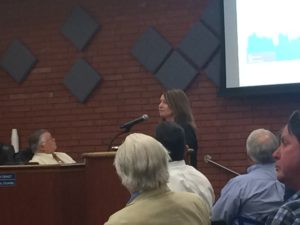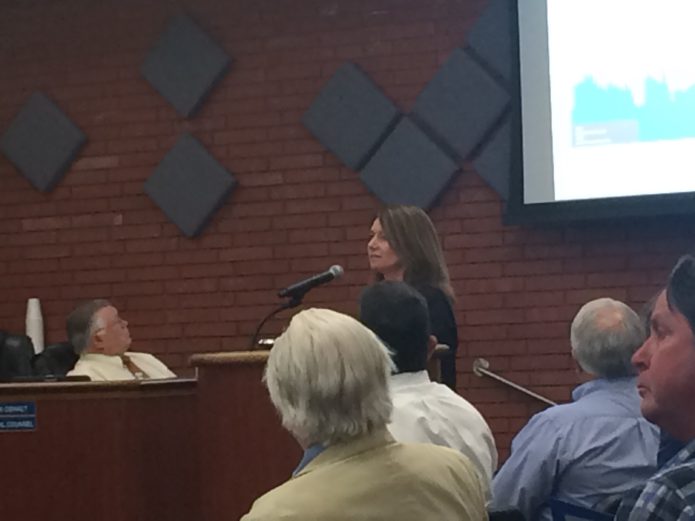
U.S.Bureau of Reclamation Commissioner Brenda W. Burman speaks to the Imperial Irrigation District Board of Directors and Imperial Valley residents regarding current risks to the Colorado River system on Tuesday, May 22. The presentation was held during an IID Board meeting at the district’s auditorium in El Centro.
U.S. Bureau of Reclamation Commissioner Brenda W. Burman spoke of the risk to the Colorado River system and the need for action in the wake of ongoing drought during an Imperial Irrigation District (IID) Board meeting on Tuesday, May 22. In her first presentation to the IID Board of Directors since confirmation as commissioner in November, Burman delivered a sobering message that the time has come to restart the stalled drought contingency planning (DCP) talks, stating a need for action in the next year to address the threat of shortage on the river. Her discussion was filled with both stark predictions for the river system should the drought continue and hope that through conservation efforts that worst-case shortage scenarios could be averted.
Joining Burman in the presentation to the IID Board was Terry Fulp, the Bureau of Reclamation’s Regional Director of the Lower Colorado River Basin. Fulp provided familiar statistics—that Lake Mead and Lake Powell, which provide storage for the Lower Basin states of Nevada, Arizona and California, are about 51 percent full. In 1999, both lakes were near capacity, but as a period of drought struck, the lakes dropped by half in just five years. That sudden loss of storage led to the development of the interim guidelines for managing a shortage on the river approved in 2007. In the years since then, he said, the river system has weathered through the ongoing drought. But a shortage declaration could come in the next two years, according to a graphic shared during the presentation, as Lake Mead teeters just above 1075 feet, the point at which a shortage could be declared. He added if not for the conservation efforts in recent years by all those who depend on the river, Lake Mead would likely already be below the 1075-foot mark.
As part of her presentation, Burman highlighted that if the drought continues, one plausible scenario is that Lake Mead levels could drop to levels well below 1,000 feet to a mark considered “dead pool,” where Lake Mead could no longer provide water deliveries to the agencies that depend on the river. For that reason, she declared “there absolutely needs to be action on the Colorado River.” She added, “The risk is too great.” Burman further said the actions taken now will not only benefit water users today by ensuring continued river operations but also serve the needs of the river system 20 years to 40 years into the future, just as water users today benefit from the actions of the pioneers who built the system under Boulder Canyon Act of 1928.
Burman said she recognizes that drought contingency discussions have ‘fallen off”, but she said they need to start again with the goal of expanding conservation efforts throughout the river system. Under questioning from the IID Board of Directors, she said “there is room” in DCP discussions to include additional storage for IID in Lake Mead, an issue IID has pushed for, and there could be flexibility in how that storage water is created. When pressed on the Salton Sea, which could be impacted by a DCP, she said a memorandum of understanding (MOU) between the State and Federal governments remains in effect on the Sea, and while the State is the lead in restoration, the Federal government remains committed to the MOU.
The talk by Burman ended on a hopeful note that actions will be taken to help the river system, but only time will tell if talks actually do restart and whether agencies can reach agreement on the critical issues related to conservation and storage.
Once critical issue that will need to be addressed is the Salton Sea. If there is additional conservation in the Imperial Valley, what impact would there be on flows to the Sea, and how would those impacts be mitigated separately from the current mitigation program under the Quantification Settlement Agreement.
The future of the river including the outcome of DCP discussions is an issue we all should watch closely.
